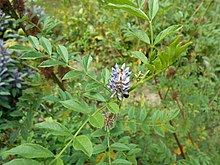Glycyrrhiza echinata
| Glycyrrhiza echinata | |
|---|---|

| |
| Scientific classification | |
| Kingdom: | Plantae |
| Clade: | Tracheophytes |
| Clade: | Angiosperms |
| Clade: | Eudicots |
| Clade: | Rosids |
| Order: | Fabales |
| Family: | Fabaceae |
| Subfamily: | Faboideae |
| Genus: | Glycyrrhiza |
| Species: | G. echinata
|
| Binomial name | |
| Glycyrrhiza echinata | |
| Synonyms[2] | |
| |
| Wikimedia Commons has media related to Glycyrrhiza echinata. |
Glycyrrhiza echinata is a species of flowering plant in the genus Glycyrrhiza, with various common names that include Chinese licorice,[3] German licorice,[3][4] and hedgehog licorice,[3] Eastern European licorice,[5] Hungarian licorice,[6] and Roman licorice.[7] It is used as a flavoring and medicinally, and to produce Russian and German licorice.[8]
Distribution[]
Glycyrrhiza echinata is native to Southeastern Europe, adjacent parts of West Asia and East Asia.[7]
Taxonomy[]
Glycyrrhiza echinata was one of the species described by Carl Linnaeus in his 1753 work Species Plantarum, the starting point for botanical nomenclature. The Latin specific epithet of echinata refers to hedgehog, from echinus maning 'prickly'.[9]
References[]
- ^ "Glycyrrhiza echinata L." Integrated Taxonomic Information System. Retrieved November 8, 2013.
- ^ The Plant List: A Working List of All Plant Species, retrieved 7 March 2017
- ^ a b c USDA GRIN Taxonomy, retrieved 7 March 2017
- ^ BSBI List 2007 (xls). Botanical Society of Britain and Ireland. Archived from the original (xls) on 2015-06-26. Retrieved 2014-10-17.
- ^ Zoë Gardner & Michael McGuffin (2013). "Glycyrrhiza spp.". American Herbal Products Association's Botanical Safety Handbook (2nd ed.). CRC Press. pp. 417–422. ISBN 9781466516946.
- ^ Debra Rayburn (2007). "Licorice". Let's Get Natural with Herbs. . pp. 265–266. ISBN 9781886940956.
- ^ a b Johannes Seidemann (2005). "Glycyrrhiza L. – licorice, liquorice, sweetwood – Fabaceae (Leguminosae)". World Spice Plants: Economic Usage, Botany, Taxonomy. Springer. pp. 169–170. ISBN 9783540222798.
- ^ Plants for a Future, retrieved 8 March 2017
- ^ Stearn, William (2004). Botanical Latin. Portland, Oregon: Timber Press. ISBN 9780881926279.
Categories:
- Glycyrrhiza
- Plants described in 1753
- Taxa named by Carl Linnaeus
- Faboideae stubs